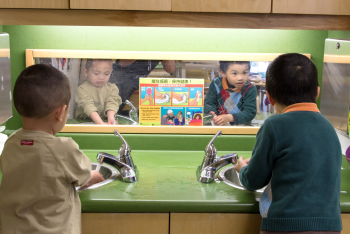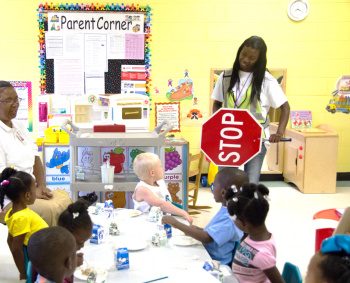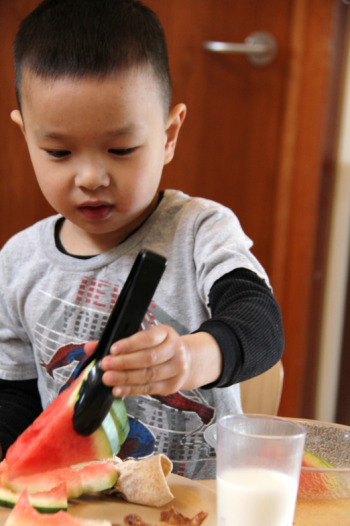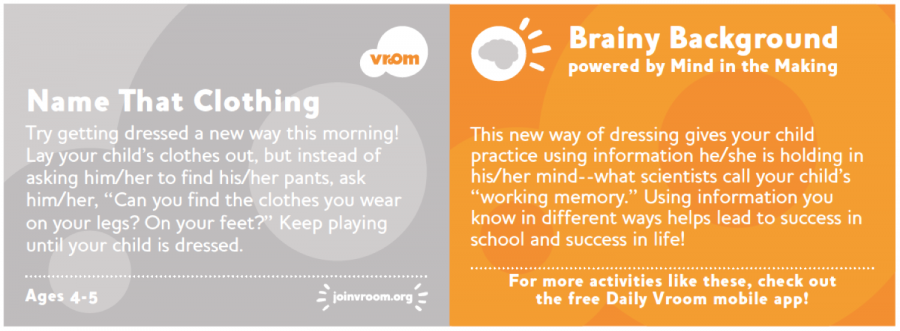3-3 Health, Safety, and Nutrition
A – Health, Safety, and Nutrition
Key Areas
Three important parts of children’s development in the subdomain Health, Safety, and Nutrition are:
- Independent self-care and hygiene practices, such as hand-washing.
- An understanding of safety, when things are safe and unsafe, and what to do if something is unsafe.
- An understanding of healthy and unhealthy foods and noticing and communicating when hungry or thirsty.
Health: Self-Care and Hygiene

By 5 years of age, children will be able to engage independently in self-care routines, such as handwashing or getting dressed.
- The development of independent self-care routines and hygiene begins around 8 months of age. At that time, some infants may begin to cooperate and even anticipate daily health routines, such as handwashing after eating or brushing teeth.
- Between 16 months and 3 years old, children will begin to take more control of their own health routines. They may try to wash their hands on their own or ask to clean their own nose. Children’s ability to independently engage in self-care routines of this kind by 3 years of age is one of the Head Start Early Learning Outcomes Framework indicators.
- Between 3 and 4 years, children will not only engage in these behaviors independently but will also begin to understand and communicate the importance of them. For example, they may explain how brushing their teeth keeps their teeth healthy.
- And by 5 years old, a child should regularly engage in some self-care routines independently, such as handwashing, tooth brushing, or getting dressed.
Safety: Safe and Unsafe

By 5 years of age, children will not only engage in basic safety practices, such as avoiding a hot stove, but will also alert others to dangers or seek out adult guidance in dangerous situations.
- Children begin developing an understanding of what is safe and unsafe and how to handle unsafe situations as early as 16 months old. At first, adults guide children in safety issues since they cannot know what the consequences of their behaviors are going to be without experiencing those negative consequences firsthand. By developing caring and responsive relationships, adults can encourage children to cooperate with them in unsafe situations, such as holding hands when walking through a parking lot or crossing the street.
- By 3 years old, however, children should have some understanding of common unsafe and safe behaviors. For instance, they should know that they shouldn’t touch a hot stove or jump off a table.
- Between 3 and 5 years old, children will begin to follow safety practices on their own. For example, children at this age may sometimes remind the adults with them that they need to hold hands when crossing a street. Children may look to adults for guidance in more complex situations.
- By 5 years of age, children should be able to alert others to dangers and identify basic safety rules.
Nutrition

By 5 years of age, children will be able to identify and communicate their own states of hunger and thirst and will have begun to make the connection between nutrition and growth.
- Nutritional development begins a little after children begin to eat solid foods. Between 8 and 18 months, infants will often show interest in trying out new foods with new tastes, smells, and textures. Parents or early learning professionals can try varying spices in cooked foods to see what a child likes and should offer food items on more than one occasion. Infants may not enjoy a particular food when they first encounter it but realize that they love it in a second encounter.
- If offered regularly in a positive manner, most children will also begin to make nutritional food choices between 16 months and 3 years.
- By 3 years, children will be able to express likes and dislikes about foods and communicate their hunger and thirst to adults.
- Between 3 and 5 years, children will begin to learn how nutrition plays a role in their own growth and development and can understand how eating a variety of foods will help them grow healthy.

Reflection Point
- What is a key skill to learn in each of these subdomains—Health, Safety, and Nutrition—and why?
- Pick one skill for each subdomain, and consider different ways that you could teach this skill to children.
B – Teaching Children about Health, Safety, and Nutrition
Modeling
Development in the areas of health, safety, and nutrition is heavily dependent on guidance and support from adults. One effective way to convey these ideas and promote development in this area is through adult modeling of healthy and safe behaviors.
Children of all ages love to learn by imitation. For example, even very young children will begin copying adults’ phone actions by holding up a toy phone or other object and pretending to have a conversation with it.
Children can also learn about healthy and unhealthy, safe and unsafe, and hygienic practices through modeling. If parents and educators model these behaviors and explain what they are doing and why, children will naturally want to copy what the adults are doing.
For example, an adult washing their own hands after mealtime encourages children to do the same. An adult eating healthy foods in front of children encourages children to want to eat those foods as well.
Explaining
Another way that children learn about these kinds of concepts is through verbal explanations.
In one example, when 2-year-old children watched two blocks touch and cause a toy plane to turn on, they were confused about the cause-and-effect relationship between the touching blocks and the toy plane. When a researcher asked the children to “make the plane go,” they didn’t know what to do.
But when a researcher provided verbal explanation, as the child watched the blocks and the plane, by saying something like, “Look, the block touching the other block makes the plane go,” even 2-year-old toddlers were easily able to then bring the blocks together to make the plane go when the researcher asked them to.
Similarly, when you tell children that they can’t have an unhealthy food, explain how too much unhealthy food can hurt rather than help the body grow. This will help children make the connection between nutrition and growth.
Children benefit from verbal explanations well before they are able to produce language of that kind on their own.
Smoothing Transitions
Transitions make it particularly difficult for children to learn the concepts of health, safety, and nutrition and hinder their ability to adopt new behaviors.
For example, a child may want to keep playing instead of washing hands, or keep running instead of stopping at the parking lot or at the end of the sidewalk, or keep eating sweets instead of proteins and veggies at dinnertime.
Making transitions easier can often help children develop in this subdomain. Some ways to make transitions easier are to:
- Individualize transitions as much as possible. Don’t expect a group of eight toddlers to all do the same activities at the same time and at the same pace.
- Reduce waiting times. Toddlers are barely patient at the best of times. Try to fill any downtime between activities with a fun activity, such as singing a song or reading a book.
- Give advance notice and reminders before transitions. And try to give children options when possible, such as, “Do you want to wash your hands at the sink on the left or the sink on the right?”
For example, stagger children’s handwashing in early learning programs so that the children who are waiting to wash their hands have something else to do. And give children a 2-minute reminder before their turn to wash hands.
Vroom Tip
Check out this Vroom tip to get more ideas about how to help children learn about health, safety, and nutrition.

View text-only alternative of this Vroom card
Name that Clothing
Try getting dressed in a new way this morning! Lay your child’s clothes out, but instead of asking him/her to find his/her pants, ask him/her “Can you find the clothes you wear on your legs? On your feet?” Keep playing until your child is dressed.
Ages 4-5
Brainy Background powered by Mind in the Making
This new way of dressing gives your child practice using the information he/she is holding in his/her mind — what scientists call “working memory.” Using information you know in different ways helps lead to success in school and success in life!
Does this tip make sense in the context of an early learning environment? And if not, how might you adapt the activity to better fit?
 References
References
Berk, L. (2013). Child development (9th ed.). Pearson.
Bonawitz, E. B., Ferranti, D., Saxe, R., Gopnik, A., Meltzoff, A. N., Woodward, J., & Schulz, L. E. (2010). Just do it? Investigating the gap between prediction and action in toddlers’ causal inferences. Cognition, 115(1), 104–117.
U.S. Department of Health and Human Services, Administration for Children and Families, Office of Head Start. (n.d.) News you can use: Transitions. [Online Article]
Vroom. (2017). Tools and resources. [Website]
EarlyEdU Alliance (Publisher). (2018). 3-3 Health, safety, and nutrition. In Child Development: Brain Building Course Book. University of Washington. [UW Pressbooks]

